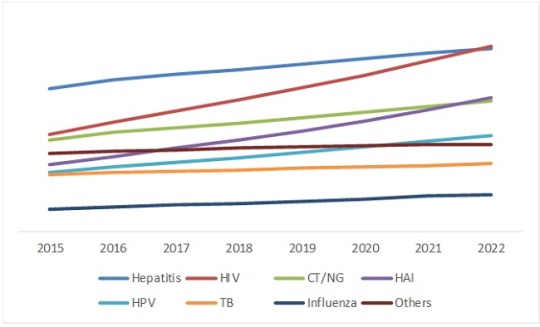#Cdiff research
Explore tagged Tumblr posts
Text

An mRNA vaccine protected mice against deadly intestinal C. difficile bacteria
Clostridioides difficile is a notoriously nasty intestinal bug, with few effective treatments and no approved vaccines. But the same technology that enabled the first COVID-19 vaccines has shown early promise, in mouse experiments, against this deadly infection, which kills 30,000 people in the United States each year.
An mRNA vaccine designed to target C. difficile and the toxins it produces protected mice from severe disease and death after exposure to lethal levels of the bacterial pathogen, researchers report in the Oct. 4 Science. While it will take much more research to see whether the vaccine is safe and effective for humans, the results hint that an mRNA vaccine might succeed where more conventional vaccines have failed.
#MRNAVaccine #ClostridiumDifficile #Cdiff #MedicalResearch #InfectiousDisease #IntestinalHealth #VaccineDevelopment #BiomedicalResearch #GutHealth #Immunotherapy #Biotechnology #AntibioticResistance #HealthInnovation #Microbiology #Vaccines
______________________________________________________________________________________________________
International Young Scientist Awards
Website link: youngscientistawards.com
Nomination Link: https://youngscientistawards.com/award-nomination/?ecategory=Awards&rcategory=Awardee
Contact Us: [email protected] _________________________________________________________________________________________________________
Social Media:
Twitter : https://twitter.com/youngsc06963908
Linkedin- : https://www.linkedin.com/in/shravya-r...
Pinterest : https://in.pinterest.com/youngscienti...
Blog : https://youngscientistaward.blogspot....
Tumblr : https://www.tumblr.com/blog/shravya9
0 notes
Text
"𝐔𝐧𝐝𝐞𝐫𝐬𝐭𝐚𝐧𝐝𝐢𝐧𝐠 𝐂𝐥𝐨𝐬𝐭𝐫𝐢𝐝𝐢𝐮𝐦 𝐃𝐢𝐟𝐟𝐢𝐜𝐢𝐥𝐞 𝐈𝐧𝐟𝐞𝐜𝐭𝐢𝐨𝐧 (𝐂𝐃𝐈)"
Clostridium difficile infection (CDI) is caused by a bacterium that affects the colon, leading to symptoms like diarrhea, abdominal pain, and fever. It is commonly associated with antibiotic use, disrupting the gut's normal bacteria balance. Treatment involves specific antibiotics, and prevention includes good infection control practices and prudent antibiotic use.
𝐅𝐨𝐫 𝐦𝐨𝐫𝐞 𝐬𝐮𝐜𝐡 𝐢𝐧𝐟𝐨𝐫𝐦𝐚𝐭𝐢𝐨𝐧 𝐨𝐫 𝐦𝐚𝐫𝐤𝐞𝐭 𝐫𝐞𝐩𝐨𝐫𝐭
Contact Wissen Research at [email protected] or for more such reports click - https://www.wissenresearch.com/market-research-report/
#CDI#Cdiff#ClostridiumDifficile#BacterialInfection#GutHealth#AntibioticUse#HealthcareInfections#Prevention#Treatment#wissenresearch#marketanalysis
0 notes
Text
Researchers Find Ultrasensitive Stool Toxin Detection and Concentration Correlated with Severe Baseline In Hospitalized Patients With C. difficile Infection
Researchers Find Ultrasensitive Stool Toxin Detection and Concentration Correlated with Severe Baseline In Hospitalized Patients With C. difficile Infection
Ultrasensitive and quantitative toxin measurement correlates with baseline severity, severe outcomes, and recurrence among hospitalized patients with Clostridioides difficile infection Carolyn D Alonso, Ciarán P Kelly, Kevin W Garey, Anne J Gonzales-Luna, David Williams, Kaitlyn Daugherty, Christine Cuddemi, Javier Villafuerte-Gálvez, Nicole C White, Xinhua Chen, Hua Xu, Rebecca Sprague, Caitlin…

View On WordPress
0 notes
Photo

RepostBy @crohnsresearch: "How challenging is a your life with #ibd during flare ups? It’s not easy but not so many people know about it and understand what you are going through... Would you like your voice to be heard? There’s exciting opportunity to help IBD research by sharing your experiences with #crohns #cdiff and #ulcerativecolitis and get $5 gift card of your choice for signing up and $100 hourly for participation. Patients of age 14 and + and caregivers (family, friends) from the USA and Canada are invited to join online. Learn about all the details in the research studies description and sign up at https://outsmartdisease.com/IBD-resources or just use the link in my instagram profile description at @crohnsresearch <<== click" (via #InstaRepost @AppsKottage) https://www.instagram.com/p/ClU4hB1rgKk/?igshid=NGJjMDIxMWI=
0 notes
Text
Clostridium Difficile Infection Treatment Market Landscape By Manufacturing Base, Trends, Influence factors, Revenue

Clostridium difficile, which produces gram-positive bacterium, is an anaerobic toxin that gets transmitted through fecal-oral route. Clostridium difficile infection occurs during antibiotic treatment or can be caused due to healthcare associated infection with clinical manifestation ranging from asymptomatic infection to watery diarrhea or serious intestinal condition such as colitis and colonic perforation. This infection can be diagnosed by enzyme immunoassays for toxins or Clostridium difficile glutamate dehydrogenase (GDH) and nucleic acid amplification tests for Clostridium difficile toxin genes or endoscopy. Limited types of drugs such as metronidazole, fidoxamycin and vancomycin are only available for the treatment of Clostridium difficile infection. In case of any severe pain or toxic megacolon in abdominal wall, patients undergo surgery for removal of infected portion. High prevalence of this disease and occasional disease outbreaks in the emerging economies are expected to drive growth of Clostridium difficile infection treatment market. However, alternative therapy for broad spectrum antibiotic such as cephalosporins or fluoroquinolone will hinder the growth of Clostridium difficile infection treatment market.
Request for Sample Copy: https://www.coherentmarketinsights.com/insight/request-sample/1492
The Global Clostridium Difficile Infection Treatment Market Taxonomy:
By Drug Class
Metronidazole
Fidoxamycin
Vancomycin
Other Drug Class
By Route of Administration
Oral
Intravenous / Parenteral
By Distribution Channel
Hospital Pharmacies
Retail Pharmacies
Online Pharmacies
The Global Clostridium Difficile Infection Treatment Market Driver
Increasing prevalence of Clostridium difficile infection to boost Clostridium difficile infection treatment market. Clostridium difficile infection is prevalent in old people, people with weak immune system, people under long term broad spectrum antibiotic, and people who have undergone intestinal surgery. As per the Centers for Disease Control and Prevention (CDC), Clostridium difficile is the major cause of healthcare associated infection causing around 500,000 infection and 29,000 deaths per year in the U.S. The recent increase in incidences and severity of Clostridium difficile is subjected to increasing use of broad spectrum antibiotic such as cephalosporins, clindamycin, penicillin or fluoroquinolone and emergence of hypervirulent NAP1/BI/ribotype 027 strains, which are more resistant to present class of antibiotics. Furthermore, lack of compliance of hygiene norms in hospitals and uncontrolled use of broad spectrum antibiotic is increasing the rate of prevalence of this infection. All these factors are expected to drive growth of Clostridium difficile infection treatment market.
Increasing incidence of Clostridium difficile infection demands for strengthening of research and development program, thereby propelling growth of Clostridium difficile infection treatment market. For instance, in 2017, Actelion conducted phase III clinical trial for comparing cadazolid with vancomycin for the treatment of Clostridium difficile associated diarrhea. Furthermore, in 2018, Rebiotix Inc., a clinical stage microbiome company initiated phase III trials for microbiota drug, RBX2660 for rehabilitation of microbial flora after Clostridium difficile infection and mechanism of restoration was demonstrated by using collaborator, CoreBiome’s BoosterShot technology. Moreover, Food and Drug Administration (FDA) designated RBX2660 as Breakthrough Therapy for its potential to prevent recurrent Clostridium difficile infection. In 2017, Finch and Crestovo merge aimed at development of microbiome pipeline for Clostridium difficile infection.
Furthermore, development of better diagnostic tools will also drive growth of Clostridium difficile infection treatment market. For instance, Quidel introduced Solana, a FDA approved molecular assay for qualitative Clostridium difficile infection detection. The company claims it as a quick and accurate diagnosis that can process 12 samples in one-shot in 35 min. Moreover, in 2017, Roche developed a Cobas Cdiff nucleic acid test for use on an automated Cobas Liat System, which uses a real time PCR for the detection of Clostridium difficile toxin B. Therefore, therapeutic and diagnostic advancements will enhance Clostridium difficile infection treatment market.
To Get Instant Access, Purchase Report Here @ https://www.coherentmarketinsights.com/insight/buy-now/1492
The Global Clostridium Difficile Infection Treatment Market – Regional Analysis
On the basis of region, the global Clostridium difficile infection treatment market is segmented into North America, Latin America, Europe, Asia Pacific, Middle East, and Africa. North America is expected to be a dominant market region over the forecast period due to increasing prevalence of Clostridium difficile infection in this region. Furthermore, European economies are expected to face a decline in Clostridium difficile infection treatment market due to mandatory surveillance, monitoring of antibiotic prescriptions, and reformed compliance with isolation, hand washing, and hygiene protocols. The statistics revealed by Public Health England suggests that Clostridium difficile infection has substantially decreased from 55,498 cases to 13,361 cases between the period of 2007- 2008 and 2013 -2014. Asia pacific is the largest market region due to poor healthcare infrastructure and facilities, and lack of hygiene conditions.
The Global Clostridium Difficile Infection Treatment Market - Competitors
The major players operating in the Clostridium difficile infection treatment market include Merck & Co., Inc., Baxter International Inc., Sanofi S.A., Pfizer limited, Novartis, Astellas Pharma Inc., Eli Lilly and Company, AstraZeneca Plc., Actelion Pharmaceuticals Ltd (Sub. of Johnson & Johnson Services, Inc.), and Mylan N.V.
About Coherent Market Insights
Coherent Market Insights is a prominent market research and consulting firm offering action-ready syndicated research reports, custom market analysis, consulting services, and competitive analysis through various recommendations related to emerging market trends, technologies, and potential absolute dollar opportunity.
Contact Us
Mr. Shah
Coherent Market Insights
1001 4th Ave, #3200
Seattle, WA 98154
Phone: US +12067016702 / UK +4402081334027
Email: [email protected]
0 notes
Text
Tweeted
Participants needed for online survey! Topic: "Share your experience having C Diff" https://t.co/DMAO4hkHC5 via @SurveyCircle#CDiff #CloridiumDifficile #OnlineInterview #experience #survey #surveycircle pic.twitter.com/JuOdUdfn88
— Daily Research @SurveyCircle (@daily_research) February 17, 2021
0 notes
Text
Global Infectious Disease Diagnostics Market is Expecting Major Surge in Revenue in Next FIVE Years..!
Growth in this market is primarily driven by the increasing global prevalence of infectious diseases, shift in focus from centralized laboratories to decentralized point-of-care testing, and growth in funding for research on infectious disease diagnostics.
The global infectious disease diagnostics market was valued at USD 13.93 Billion in 2016 and projected to reach USD 19.35 Billion in 2022, at a CAGR of 5.6%.
What Drives the Market?
1. Increasing global prevalence of infectious diseases 2. Shift in focus from centralized laboratories to decentralized point-of-care testing 3. Growth in funding for research on infectious disease diagnostics
Get a sample PDF copy of the Report @ https://www.marketsandmarkets.com/pdfdownloadNew.asp?id=116764589

The global prevalence of infectious diseases such as influenza, HPV, hepatitis, HIV, and tuberculosis is considerably high in spite of significant improvements in sanitation practices and medicine. Many of the currently available diagnostic techniques are slow, involve complex procedures, and lack specific identification of causative agents.
On the basis of disease type, the infectious disease diagnostics (IDD) market is segmented into a wide range of diseases. Hospital acquired infections (HAI) segment to record the highest CAGR during the forecast period. Growth in HAI segment can be attributed to the rising burden of MRSA infections, the increasing number of new products launched in the market, and increasing adoption of technologically advanced HAI diagnostic tests such as BD MAX Cdiff assay, Xpert MRSA NxG, and ARIES C. difficile Assay that are based on PCR technology
The geographical regions mapped in the report are: 1. North America 2. Europe 3. Asia-Pacific 4. Rest of the World (RoW)
North America accounted for the largest share of the global infectious disease diagnostics market. The large share of this region is mainly attributed to the presence of a highly developed healthcare system, increasing prevalence of infectious diseases, the presence of a large number of leading national clinical laboratories, and easy accessibility to technologically advanced instruments in the region.
Some key players mentioned in the research report are:
Abbott Laboratories, Becton, Dickinson and Company, Biomérieux SA, Bio-Rad Laboratories, Danaher Corporation, Diasorin, Luminex, Meridian Bioscience, Quidel, Roche Diagnostics, Siemens AG, Thermo Fisher Scientific
Get Sample Report @ https://www.marketsandmarkets.com/requestsampleNew.asp?id=116764589.
0 notes
Text
Clostridium Difficile Infection Treatment Market Report 2026
To Gain More Insights into the Clostridium Difficile Infection Treatment Market, Browse Summary of the Research Report –
Clostridium difficile, which produces gram-positive bacterium, is an anaerobic toxin that gets transmitted through fecal-oral route. Clostridium difficile infection occurs during antibiotic treatment or can be caused due to healthcare associated infection with clinical manifestation ranging from asymptomatic infection to watery diarrhea or serious intestinal condition such as colitis and colonic perforation. This infection can be diagnosed by enzyme immunoassays for toxins or Clostridium difficile glutamate dehydrogenase (GDH) and nucleic acid amplification tests for Clostridium difficile toxin genes or endoscopy. Limited types of drugs such as metronidazole, fidoxamycin and vancomycin are only available for the treatment of Clostridium difficile infection. In case of any severe pain or toxic megacolon in abdominal wall, patients undergo surgery for removal of infected portion. High prevalence of this disease and occasional disease outbreaks in the emerging economies are expected to drive growth of Clostridium difficile infection treatment market. However, alternative therapy for broad spectrum antibiotic such as cephalosporins or fluoroquinolone will hinder the growth of Clostridium difficile infection treatment market.
https://www.coherentmarketinsights.com/ongoing-insight/clostridium-difficile-infection-treatment-market-1492
Increasing prevalence of Clostridium difficile infection to boost Clostridium difficile infection treatment market. Clostridium difficile infection is prevalent in old people, people with weak immune system, people under long term broad spectrum antibiotic, and people who have undergone intestinal surgery. As per the Centers for Disease Control and Prevention (CDC), Clostridium difficile is the major cause of healthcare associated infection causing around 500,000 infection and 29,000 deaths per year in the U.S. The recent increase in incidences and severity of Clostridium difficile is subjected to increasing use of broad spectrum antibiotic such as cephalosporins, clindamycin, penicillin or fluoroquinolone and emergence of hypervirulent NAP1/BI/ribotype 027 strains, which are more resistant to present class of antibiotics. Furthermore, lack of compliance of hygiene norms in hospitals and uncontrolled use of broad spectrum antibiotic is increasing the rate of prevalence of this infection. All these factors are expected to drive growth of Clostridium difficile infection treatment market.
Increasing incidence of Clostridium difficile infection demands for strengthening of research and development program, thereby propelling growth of Clostridium difficile infection treatment market. For instance, in 2017, Actelion conducted phase III clinical trial for comparing cadazolid with vancomycin for the treatment of Clostridium difficile associated diarrhea. Furthermore, in 2018, Rebiotix Inc., a clinical stage microbiome company initiated phase III trials for microbiota drug, RBX2660 for rehabilitation of microbial flora after Clostridium difficile infection and mechanism of restoration was demonstrated by using collaborator, CoreBiome’s BoosterShot technology. Moreover, Food and Drug Administration (FDA) designated RBX2660 as Breakthrough Therapy for its potential to prevent recurrent Clostridium difficile infection. In 2017, Finch and Crestovo merge aimed at development of microbiome pipeline for Clostridium difficile infection.
“We Do Offer Sample of Clostridium Difficile Infection Treatment Market Report. Kindly go through the follow information in order to access sample copy.”
https://www.coherentmarketinsights.com/insight/request-sample/1492
Furthermore, development of better diagnostic tools will also drive growth of Clostridium difficile infection treatment market. For instance, Quidel introduced Solana, a FDA approved molecular assay for qualitative Clostridium difficile infection detection. The company claims it as a quick and accurate diagnosis that can process 12 samples in one-shot in 35 min. Moreover, in 2017, Roche developed a Cobas Cdiff nucleic acid test for use on an automated Cobas Liat System, which uses a real time PCR for the detection of Clostridium difficile toxin B. Therefore, therapeutic and diagnostic advancements will enhance Clostridium difficile infection treatment market.
Table of Contents
https://www.coherentmarketinsights.com/ongoing-insight/toc/1492
Top players in the market
The major players operating in the Clostridium difficile infection treatment market include Merck & Co., Inc., Baxter International Inc., Sanofi S.A., Pfizer limited, Novartis, Astellas Pharma Inc., Eli Lilly and Company, AstraZeneca Plc., Actelion Pharmaceuticals Ltd (Sub. of Johnson & Johnson Services, Inc.), and Mylan N.V.
Research methodology adopted by Coherent Market Insights
Coherent Market Insights followsa comprehensive research methodology focused on providing the most precise market analysis. The company leverages a data triangulation model which helps company to gauge the market dynamics and provide accurate estimates. Key components of the research methodologies followed for all our market reports include:
Primary Research (Trade Surveys and Experts Interviews)
Desk Research
Proprietor Data Analytics Model
In addition to this, Coherent Market Insights has access to a wide range of the regional and global reputed paid data bases, which helps the company to figure out the regional and global market trends and dynamics. The company analyses the industry from the 360 Degree Perspective i.e. from the Supply Side and Demand Side which enables us to provide granular details of the entire ecosystem for each study. Finally, a Top-Down approach and Bottom-Up approach is followed to arrive at ultimate research findings.
Request A Sample Copy Clostridium Difficile Infection Treatment Market Report Click here:
https://www.coherentmarketinsights.com/insight/request-sample/1492
Get PDF Research Report Brochure @
https://www.coherentmarketinsights.com/insight/request-pdf/1492
Buy Now this Premium Report to Grow your Business @
https://www.coherentmarketinsights.com/insight/buy-now/1492
About Us:
Coherent Market Insights is a global market intelligence and consulting organization focused on assisting our plethora of clients achieve transformational growth by helping them make critical business decisions.
Contact Us:
Name: Mr. Raj Shah
Email: [email protected]
Phone: US +12067016702
Country: United States
Visit our Blog: https://hospitalhealthcareblog.wordpress.com/
0 notes
Text
The microbiome: Images and visualisations
On Monday 26 June I went to Oxford to participate in a workshop on the microbiome organised by The Oxford Interdisciplinary Microbiome Project (IMP). This was what one might call a meta-workshop. Its aim was to find questions that social scientists can sensibly ask about the microbiome, or in the words of the organisers, this was about establishing a “social-scientific research agenda about the microbiome and its implications for public policy and social change”. The workshop ties in with some of my older and newer reflections on the microbiome.
The Oxford English Dictionary defines the microbiomes in two ways, as “[a] population of microorganisms inhabiting a specific environment; a microbial community or ecosystem, now esp. that of the body” (first attested in 1952) and as “[t]he collective genomes of all the microorganisms inhabiting a specific environment, esp. that of the body” (first attested in 2001).
The workshop was held at Wolfson College (see featured image), where I did my JRF in the history of linguistics between 1985 and 1988. It was really nice to be there again and see all the new additions and extensions.
Questions, questions questions
In advance of the workshop we had been sent 120 questions and were asked to vote for 10. At the workshop itself each of four tables/working groups was given a list of themed questions and we were asked to select two high-level ones and two reserve questions. The general aim was to establish about 20 questions overall.
At our table we dealt with the issue of how the microbiome is being conceptualised. One question we found interesting in this context was how the microbiome, a still rather abstract and contested concept, is being imagined and visualised in the public sphere (which is, of course, not the same as visualising microbiome datasets).
While we were discussing this, I quickly had a peak on Google Images and what I found was quite intriguing. So when I came back from Oxford, I had a closer look. Of course, I cannot provide an answer to the broad question of how the microbiome is visualised in the public sphere in one blog post, but perhaps I can stimulate some discussion.
People can also look at other image sources in the future, such as Pinterest, Shutterstock, or the Science Photo Library, for example, which have images of the microbiome that seem to be quite different to the Google Images sample.
Thematic clusters
When you search for ‘microbiome’ on Google Images, you get not only images, but Google also provides you with a list of ‘themes’ (in various colours). (I searched on 27 June)
I am not sure how these themes are generated, but they are really interesting. Here they are without the colours – followed by my attempts at interpreting these thematic clusters:
skin, gut, lung, human skin, colon, stomach – this theme seems to deal with loci of various types of human microbiome
nature, role, health, diet, environmental, food – this one hints at various contexts of the human gut microbiome and how it is fed or maintained
plant, animal, host – here we are dealing with a simple (almost) dichotomy between plant and animal hosts of microbiomes
obesity, disease, cancer, diabetes, dysbiosis [microbial imbalance or maladaptation on or inside the body, such as an impaired microbiota], ibd [inflammatory bowel disease] – this theme encapsulates various illnesses or diseases linked to a disturbed microbiome
Scientific American, New Yorker, Time Magazine, National Geographic, Nature Review, The Economist – here we have a list of the main outlets for microbiome images
core, cell, body, root, fibre, sequence – this list leaves me a bit perplexed – comments welcome
infographic, map, heatmap, pie chart – here we have a list of various types of visualisations of the microbiome
bacterial, microbiota, fungal, candida, candida albicans [a type of yeast that is commonly used as a model organism for biology], C. difficile – this list homes in on various types of microbiome as well as one of the most talked-about afflictions, Cdiff, linked to a disruption of the microbiome in the human gut
human gut, rhizosphere, human intestine, insect gut, phyllosphere [a term used in microbiology to refer to the total above-ground portions of plants as habitat for microorganisms] – here the focus is on the human gut on the one hand but also the insect gut and plant habitats for microorganism – a bit of a strange mix I have to confess
fish, chicken, lefse [a traditional soft Norwegian flatbread], milk, poultry – this might refer to ways of enhancing the microbiome through various types of food
immune system, metabolism, digestive system, antibiotic resistance, hygiene hypothesis – these are scientific topics discussed in the context of microbiome research, and they were also discussed at the workshop
hospital, home, stable – these are, it seems, some places where microbiomes like to evolve
alpha diversity, relative abundance, beta diversity – comments welcome! Alpha diversity refers, it seems, to the diversity of species at a specific site (local species pool), while beta diversity represents the differences in species composition among sites
metagenomics, metabolomics, next generation sequencing – these are high-level science topics as well as technologies relating to research in microbiomics
human milk, saliva, blood – this might refer to interactions between a mother’s breast milk and a baby’s saliva; I am not so sure about the blood
dog, ruminant, pig, swine, bovine, equine – this indicates that microbiomics deals not only with humans but also animals that humans keep and eat
short chain fatty acid, tmao [Trimethylamine N-oxide (TMAO) is a small colorless amine oxide generated from choline, betaine, and carnitine by gut microbial metabolism], bile acid – comments welcome!
drosophila, human genome, coral, zebrafish, termite, mosquito – these might be model organisms used in the study of microbiomes (apart from the human genome)
sem [structural equation modelling or scanning electon microsope?], 16s rrna sequencing [the component of the 30S small subunit of a prokaryotic ribosome that binds to the Shine-Dalgarno sequence] – science!
pca [principal component analysis], hierarchical clustering, gastric bypass, otu [operational taxonomic unit] – I am not sure what gastric bypass is doing in this list!
Overall, these themes provide some insights not only into who generates most of the images, i.e. which journals are involved, or which types of images and visualisations are used, but also, and more importantly, what topics these images and visualisations are supposed to illuminate, from types of (human) microbiome, through various loci for microbiomes, through (domestic) animal microbiomes, to ways of studying the microbiome in certain fields of science and by using certain techniques, technologies and machines. Surprisingly, these themes did not mention Faecal Microbial Transplants, which are increasingly being discussed in the context of the microbiome.
Types of images and visualisations
I then looked at the first fifty images that were displayed when I searched for ‘microbiome’. I sorted them roughly into the following groups and I list them below in order of importance:
Outlines of human body/bodies/head/hands
Rod-shaped bacteria milling about
Microbiome as a word with or without other text
Various types of bacteria or cells milling about (sometimes) under a microscope
One cartoon
Surprisingly, I could not immediately see an image of a human gut – the most popular location of the microbiome. (Such images seem to be much more prominent on Shutterstock; while rod-shaped bacteria seem to be the domain of the Science Photo Library).
The images based on outlines of the human body were mostly outlines with arms slightly raised; sometimes there were two outlines, for example, of a man and a woman (skirt) standing beside each other; sometimes there were several outlines; sometimes the outline merged with an image of the double helix; sometimes there were outlines of a head or of two hands. The outlines were mostly inhabited or surrounded by round or rod-shaped outlines of microbes. This type of image also included the logo of Human Microbiome Project which adapts Leonardo de Vinci’s Vitruvian Man to the genomic age:
The images that displayed the word ‘microbiome’ were also interesting. Sometimes I just saw the word ‘microbiome’ surrounded by bacterial fuzziness, or else as part of a wordle; or ‘Microbiome 101’ against a background of swirling bacterial soup. There were also images that displayed texts such as: ‘What is the Microbiome?’, ‘Gut Feeling’, ‘The importance of your gut microbiome for your optimal health’, ‘Your body is mostly microbes’, ‘How to feed your microbiome’, and so on. Interestingly, the focus of the words, rather than the images, was on the human gut.
Conclusion
The images and visualisations of the microbiome desplayed on Google Images provide a unique and also biased insight into what types of images are out there of the microbiome. There were three surprises: the absence of faecal microbial transplants as topic or theme; the absence of the human bowel as an image; and the focus on the human gut in the words but not in the images. At the moment I can’t provide an explanation for this. More research needed!
Images: Wikimedia commons
The post The microbiome: Images and visualisations appeared first on Making Science Public.
via Making Science Public http://ift.tt/2snkAS0
0 notes
Text
Researchers Find C. diff. a Major Cause of Nosocomial Diarrheal Disease Exhibits Phenotypic Heterogeneity Within a Clonal Population As a Result of Phase Variation
Researchers Find C. diff. a Major Cause of Nosocomial Diarrheal Disease Exhibits Phenotypic Heterogeneity Within a Clonal Population As a Result of Phase Variation
Recent work has revealed that Clostridioides difficile, a major cause of nosocomial diarrheal disease, exhibits phenotypic heterogeneity within a clonal population as a result of phase variation.
Many C. difficilestrains representing multiple ribotypes develop two colony morphotypes, termed rough and smooth, but the biological implications of this phenomenon have not been explored. Here, we…
View On WordPress
0 notes
Text
CspC Plays a Critical Role in Regulating C. diff. Spore Germination in Response to Multiple Environmental Signals.
CspC Plays a Critical Role in Regulating C. diff. Spore Germination in Response to Multiple Environmental Signals.
Abstract
The gastrointestinal pathogen, Clostridioides difficile, initiates infection when its metabolically dormant spore form germinates in the mammalian gut. While most spore-forming bacteria use transmembrane germinant receptors to sense nutrient germinants, C. difficileis thought to use the soluble pseudoprotease, CspC, to detect bile acid germinants. To gain insight into CspC’s unique…
View On WordPress
#c diff research#C diff Spores#C. difficile CspC#C.difficile research abstract#Cdiff research#Clostridioides difficile Infection#Clostridioides difficile Infection Study#CspC#pseudoprotease
0 notes
Text
University of Virginia School of Medicine Researchers Find Why Certain Patients Are Highly Susceptible to C.diff. Infections
University of Virginia School of Medicine Researchers Find Why Certain Patients Are Highly Susceptible to C.diff. Infections
The new finding from the University of Virginia School of Medicine (UVA) explains why certain patients are highly susceptible
to C. diff infections, provides doctors with a way to predict disease severity and points to a new way to treat the often-deadly condition.
The UVA researchers found that the immune response to C. diff causes tissue damage and even death through a type of immune cell…
View On WordPress
#Cdiff research#cdifficile research#Dr William A. Petri Jr#University of Virginia School of Medicine#University of Virginia School of Medicine Cdiff#University of Virginia School of Medicine IBD
0 notes
Text
Researchers at Chinese University of Hong Kong Develop Fluorescent Microrobots to Detect C.diff.
Researchers at Chinese University of Hong Kong Develop Fluorescent Microrobots to Detect C.diff.
Researchers at Chinese University of Hong Kong (CUHK) have developed fluorescent microrobots that can spot C. diff in a stool sample within a matter of minutes without relying on expensive laboratory equipment.
The technology relies on fungi spore-inspired microrobots that feature fluorescent functionalised carbon nanodots. When the microrobots encounter toxins produced by C. diff, the…
View On WordPress
#CDI research#Cdiff diagnostic research#Cdiff research#Cdiff science#cdifficile research#Chinese University of Hong Kong#Clostridium research#fluorescent microbots#microbots#microbots for detection of C.diff#nanoparticles#science advances
0 notes
Text
Study Finds Factors That May Help Predict Which Patients Are More Likely to Develop a CDI
Study Finds Factors That May Help Predict Which Patients Are More Likely to Develop a CDI
A cluster of factors may help predict which patients are likely to develop Clostridium difficile infection, a new study has found. And that could help in efforts to prevent infection, according to the researchers.
Reduced immune function, recent antibiotic use, current or recent hospitalization and prior C. difficile infection predicted risk of subsequent infection, opening the door to potential…
View On WordPress
#Are there C.difficile studies for fecal transplants?#Cdiff research#Cdiff treatment research#Center for Individualized Medicine Mayo Clinic#Clostridium difficile Research#Clostridium difficile research and development#dysbiotic#fecal transplant studies for Clostridium difficile#National Institutes of Health#Ohio State University#Vanessa Hale of Ohio State University.
0 notes
Photo

RepostBy @crohnsresearch: "How challenging is a your life with #ibd during flare ups? It’s not easy but not so many people know about it and understand what you are going through... Would you like your voice to be heard? There’s exciting opportunity to help IBD research by sharing your experiences with #crohns #cdiff and #ulcerativecolitis and get $5 gift card of your choice for signing up and $100 hourly for participation. Patients of age 14 and + and caregivers (family, friends) from the USA and Canada are invited to join online. Learn about all the details in the research studies description and sign up at https://outsmartdisease.com/IBD-resources or just use the link in my instagram profile description at @crohnsresearch <<== click" (via #InstaRepost @AppsKottage) https://www.instagram.com/p/ClU3LUIpuLc/?igshid=NGJjMDIxMWI=
0 notes
Text
Infectious Disease Diagnostics Market – Analysis of Worldwide Industry Trends and Opportunities
Growth in this market is primarily driven by the increasing global prevalence of infectious diseases, shift in focus from centralized laboratories to decentralized point-of-care testing, and growth in funding for research on infectious disease diagnostics.
The global infectious disease diagnostics market was valued at USD 13.93 Billion in 2016 and projected to reach USD 19.35 Billion in 2022, at a CAGR of 5.6%.
What Drives the Market?
1. Increasing global prevalence of infectious diseases 2. Shift in focus from centralized laboratories to decentralized point-of-care testing 3. Growth in funding for research on infectious disease diagnostics

Get a sample PDF copy of the Report @ https://www.marketsandmarkets.com/pdfdownloadNew.asp?id=116764589
The global prevalence of infectious diseases such as influenza, HPV, hepatitis, HIV, and tuberculosis is considerably high in spite of significant improvements in sanitation practices and medicine. Many of the currently available diagnostic techniques are slow, involve complex procedures, and lack specific identification of causative agents.
On the basis of disease type, the infectious disease diagnostics (IDD) market is segmented into a wide range of diseases. Hospital acquired infections (HAI) segment to record the highest CAGR during the forecast period. Growth in HAI segment can be attributed to the rising burden of MRSA infections, the increasing number of new products launched in the market, and increasing adoption of technologically advanced HAI diagnostic tests such as BD MAX Cdiff assay, Xpert MRSA NxG, and ARIES C. difficile Assay that are based on PCR technology
The geographical regions mapped in the report are: 1. North America 2. Europe 3. Asia-Pacific 4. Rest of the World (RoW)
North America accounted for the largest share of the global infectious disease diagnostics market. The large share of this region is mainly attributed to the presence of a highly developed healthcare system, increasing prevalence of infectious diseases, the presence of a large number of leading national clinical laboratories, and easy accessibility to technologically advanced instruments in the region.
Some key players mentioned in the research report are:
Abbott Laboratories, Becton, Dickinson and Company, Biomérieux SA, Bio-Rad Laboratories, Danaher Corporation, Diasorin, Luminex, Meridian Bioscience, Quidel, Roche Diagnostics, Siemens AG, Thermo Fisher Scientific
Get Sample Report @ https://www.marketsandmarkets.com/requestsampleNew.asp?id=116764589
0 notes